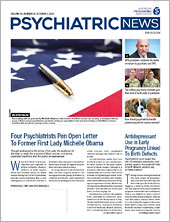People who watched a 90-second video of a young woman describing her experience with schizophrenia had a lower rate of stigma toward people with schizophrenia than those who did not watch this video. The findings were published in Schizophrenia Bulletin.
“Stigma creates a huge barrier for people with psychosis to getting care, and studies show that 70% of people with serious mental illness do not seek out treatment,” lead author Doron Amsalem, M.D., an associate research scientist at Columbia University, told Psychiatric News.
The length of time that people with psychosis go without treatment impacts their long-term outcome. “Before we talk about treatments, let’s help people be comfortable with seeking out care,” Amsalem said.
Amsalem and colleagues used a crowdsourcing tool to recruit 1,203 individuals aged 18 to 30 who were living in the United States. The participants were randomly assigned to view the 90-second video, read a text version of the same patient’s story, or be part of a control group that did not see the video or read the text.
The video featured a 22-year-old woman with schizophrenia who talked not just about her symptoms and her treatment, but about how her condition affected her daily life. The 90-second video was an abbreviated version of an 11-minute video created by the Center for Practice Innovation at ONTrackNY, the coordinated first-episode psychosis (FEP) treatment program at NYSPI.
The researchers then assessed stigma among the three groups using a web-based questionnaire that looked at five domains of stigma:
•
Social distance assesses whether someone would be willing to be friends with someone with psychosis or schizophrenia or have a person with schizophrenia marry into their family.
•
Social restriction determines a participant’s perception of whether a person with schizophrenia should marry and have children.
•
Separateness measures perceptions of whether and how much an individual with schizophrenia is different from other people.
•
Stereotyping assesses perceptions of whether people with schizophrenia are able to perform certain functions (make treatment decisions or manage their own finances) or are capable of violence.
•
Perceived recovery measures participants’ beliefs that a person with schizophrenia can follow through on a treatment plan and reach recovery goals.
The researchers found that across all five domains, the video-based intervention group had lower rates of stigma than the control group. The video group also had lower rates of stigma on measures of social distance, stereotyping, and social restriction than the group who read the patient vignette; there was no difference on measures of separateness and perceived recovery between these two groups.
The group who read the vignette had lower rates of stigma than the control group across all five domains.
In comments to Psychiatric News, Amsalem emphasized the emotionally appealing nature of the patient in the audiovisual presentation: In a direct and honest manner, she presents the story of a young adult with psychosis who has successfully engaged in treatment and lives a meaningful and productive life.
Lisa Dixon, M.D., director of OnTrackNY and a co-author of the study, said OnTrackNY has many similarly powerful videos that highlight the lived experiences of people with mental illness. “Mental illness is so objectified, but these kinds of stories just break through that by [allowing others] to see them as human beings like the rest of us, struggling and trying their best.
“They don’t present a perfect world, or a perfect life,” Dixon said. “These videos present a regular person being a regular person, coping with challenges and trials. We think they work by creating connection and identification.”
Amsalem and colleagues also emphasized that the target audience to which the video was aimed is crucial, since its age range overlaps with that of the onset of FEP and includes the potential peer group of people with FEP. Targeting this group also “intervenes in addressing stigma-related experiences when people are still young, rather than letting stereotypical attitudes endure,” they wrote. “This age group also cares greatly about what their peers think of them.”
The researchers concluded, “This simple, brief, easy to disseminate video-based intervention has the potential to increase the likelihood of seeking services, improve access to care among people with FEP, and ultimately reduce DUP [duration of untreated psychosis].” ■
“Reducing Stigma Toward People With Schizophrenia Using a Brief Video: A Randomized Controlled Trial of Young Adults” is posted
here.


